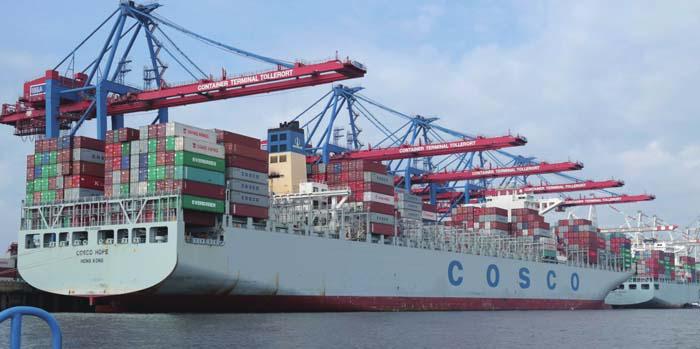Transformation and upgrade of foreign trade commodity structure:A leap from“Made in China”to“Created in China”
2019-02-20

Recently, Zou Zhiwu, a member and Deputy-Director of the CPC Committee of the General Administration of Customs, P. R. China, delivered a speech on the “Guoshi Forum 2018 Annual Meeting” themed on“New Era: Reform and Opening-up,” pointing out that growth of Chinas foreign trade has been the best miniature of historical achievements and changes made by China since Chinas adoption of the reform and opening-up policy. Over the past four decades, Chinas foreign trade scale has been expanding, turning China from a large trade destination into a trade superpower. Similarly, Chinas foreign trade commodity structure has been transformed from “Made in China” to “Created in China.”
Gradual upgrade of the foreign trade scale
Zou Zhiwu said Chinas customs work is at the forefront of Chinas reform and opening-up, which has witnessed the legendary growth of Chinas foreign trade since the reform and opening-up period.
Zou introduced, over the past four decades, Chinas foreign trade scale has realized steady progress from a large trade destination to a trade superpower. In 1999, Chinas foreign trade listed itself into the top 10 of global trade. Following Chinas entry into the World Trade Organization (WTO), Chinas reform and opening-up process has been ushered into an all-around, multilayered and cross-field historical period. In 2004, Chinas foreign trade volume surpassed one trillion USD the first time, which doubled in 2006 to exceed two trillion USD. It took just three years for Chinas foreign trade to realize the impressive leap, but the same leap took America and Germany around eight years to materialize. In 2009, Chinas export overtook that of Germany to become the largest exporter in the world. In 2013, China overtook the United States to become the global largest goods trade destination. Over the past 40 years, Chinas goods import and export grew by 198 folds in total, and Chinas contribution to global import and export has soared up from 0.77% in the very beginning to the current 11.48%.
Zou added that the past four decades have seen China playing a growingly important role in foreign trade, injecting the economic growth of China and the world with a robust driving force. Foreign trade is a booster of economic growth. Chinas foreign trade has been growing at an average annual rate of 14.5%, which is significantly higher than the annual average growth (11.9%) of Chinas GDP over the same period. This is the outcome calculated by USD. As one of the three drivers of economic development, export growth can vigorously promote expansion of the domestic industrial production.
Over the past 40 years, Chinas export international share has risen from 0.8% in 1978 to 12.8% in 2017. Currently, Chinas international market share in exporting 1,400 commodities ranks No. 1. Foreign trade is also a stabilizer of employment expansion. At present, there have been around 200 million people getting employed, either directly or indirectly through Chinas foreign trade development. Moreover, foreign trade is a balancer of international balance of payments. With the continuous widening of Chinas trade surplus, foreign trade will play a bigger role in increasing foreign currency reserve.
Zou said the trade surplus in 2005 exceeded 100 billion USD in 2005, and the figure for 2015 reached a record high of around 593.9 billion USD. During the same period, Chinas foreign exchange reserve climbed from less than one trillion USD to more than three trillion USD. So far, Chinas foreign trade has been one of the major engines to boost the worlds trade growth. Economies, either developed or emerging, show a growing reliance on Chinas trade. Now, China has been the largest trade partner of 130 countries in the world. This suffices to show that China has undoubtedly become the mainstay in the worlds trade activities.
Transformation and upgrade of the foreign trade commodity structure
According to Zous introduction, Chinas foreign trade commodity structure has been transformed from “Made in China” to “Created in China” over the past four decades. In the first three decades following Chinas adoption of reform and opening-up, Chinas export started from scratch to sell goods “Made in China” to countries all over the world. In the recent ten years, Chinas foreign trade has switched from the high-speed development stage to the high-quality development stage. The influence of “Created in China”is deepening. Chinas export is gradually getting rid of its reliance on resources and labor force. The exportoriented industries have been gradually transformed from the traditional labor-intensive industries, such as light textile, to the capital-intensive and technologyintensive industries represented by the equipment manufacturing industry, new-and high-tech industry, etc. Chinas high value-added products, including high-speed railway, aerospace and communication equipment have been expanding their overseas market.
Zou said that the largest export goods of China in 1986 were textile products and apparels. In 1995, electromechanical products replaced textiles and apparels to become the No. 1 export goods. This also symbolized the transformation of Chinas export goods from labor-intensive ones to capital-intensive or technology-intensive ones. In 2003, electromechanical products took up half of Chinas export volume the first time. In 2011, the export of Chinas electromechanical products exceeded one trillion USD. In 2017, the figure grew to 1.32 trillion USD, accounting for nearly 60% of Chinas total export volume and reaching a record high in history.
Over the past four decades, Chinas foreign trade subjects have been blooming from monopolization of state-owned enterprises to rapid development of foreign-invested enterprises to sudden rise of privatelyemployed enterprises. Before 1992, state-owned enterprises and foreigninvested enterprises were the only players in Chinas foreign trade market. In 1993, privately-employed enterprises appeared. In 1998, foreigninvested enterprises overtook state-owned enterprises to become the largest player in Chinas import and export market.
Since 2008, the performance pf privately-employed enterprises has been impressive. The total import and export volume of Chinese privatelyemployed enterprises had increased from 536 billion USD in 2008 to 1.5815 trillion USD in 2017, registering an average annual growth rate of 12.8%. The growth rate was higher than that of Chinas total import and export by 7.4%, and its percentage in the national import and exported climbed from 20.9% to 38.5% by a large margin.
